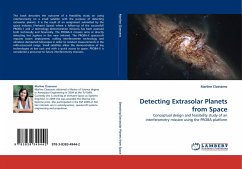This book describes the outcome of a feasibility study on using interferometry on a small satellite with the purpose of detecting extrasolar planets. It is the result of an assignment submitted by the space industry (Verhaert Space) where a follow-up of the successfull PROBA-1 and -2 technology demonstration missions has been assessed both technically and financially. The PROBA-X mission aims at directly detecting hot Jupiters in the near infrared. The PROBA-X spacecraft requires boom deployment, nulling interferometer technology and vibration dampened telescopes in order to conduct measurements in the milli-arcsecond range. Small satellites allow the demonstration of key technologies at low cost and with a quick access to space. PROBA-X is considered a precursor to future interferometry missions.
Hinweis: Dieser Artikel kann nur an eine deutsche Lieferadresse ausgeliefert werden.
Hinweis: Dieser Artikel kann nur an eine deutsche Lieferadresse ausgeliefert werden.








